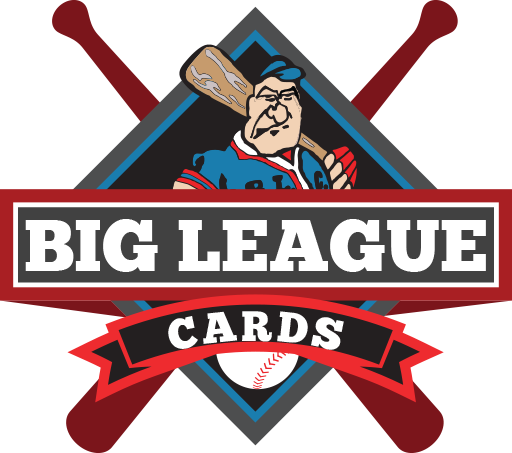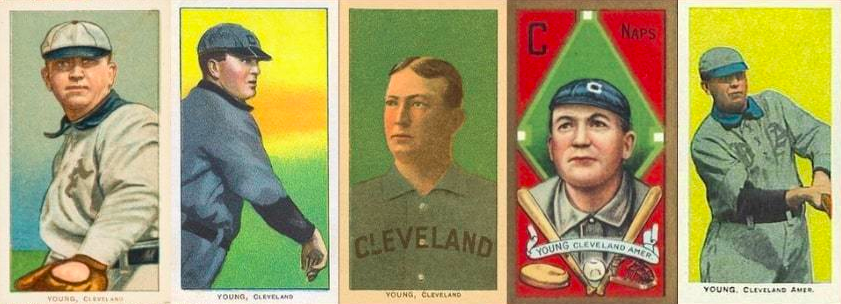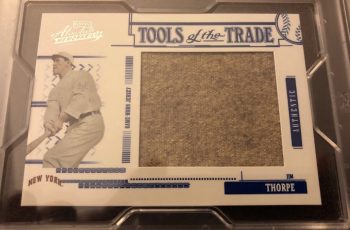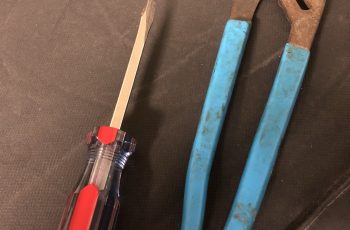Inside the Pack: The 5 Vintage Players with the Most Staying Power
I generally view card collecting as something I do for enjoyment only, rather than for investment purposes. I’ve often told people that if all of my personal collection cards were suddenly worthless, it wouldn’t matter because I bought them for my appreciation, rather than their price’s appreciation. That having been said, it’s certainly nice for your assets to gain value while you own them, and in an ideal world you’d like to be able to sell your collection for a profit should the need ever arise. With that in mind, this list identifies five players vintage players who I think have the best potential to continue growth over the next few decades and well into multiple generations from now. I chose one player from each two-decade span, but chose 2 players from the 1960s-1970s because there are more players to pick from in that span and more baseball cards available from those years.
1900s-1910s: Cy Young – Cy Young was one of the premier pitchers in baseball’s infancy. Young was one of the league’s best pitchers in 1892 and also one of the league’s best pitchers in 1908. As The Athletic’s Joe Posnanski notes, in that timeframe baseball changed immensely – the pitching mound moved from 50 feet to 60 feet 6 inches; foul balls were classified as strikes; the American League became a major league; the mound was lowered; and pitchers were no longer allowed to apply foreign substances to a baseball. Yet through it all, Young was one of the greatest hurlers in the world. He has two tremendous claims to fame for appearing on this list. First, he holds baseball’s all-time career wins total with 511, which may very well be the most unbreakable record in professional sports. (Think about this: the last pitcher to win so many as 25 games was Bob Welch, who won 27 in 1990. It would take 20 years of 25 wins, plus another 11 wins scattered around, just to tie the record.) But most importantly, MLB’s annual pitching awards hold his name. Cy Young is the most uttered non-active pitcher’s name, aside from Tommy John. He will stay in public consciousness until and unless the league renames the awards, and even if that were to happen, he still has the wins record going for him.
1920s-1930s: Babe Ruth – This one is a no-brainer. Ruth is far and away the most famous baseball player of all time, even now, roughly 85 years after he played his last game. In his time he was also one of the most famous Americans in general, as well as America’s most famous golfer. Many still argue that Babe is the true single-season home run king, since Roger Maris had a longer schedule and the likes of Sosa, McGwire, and Bonds allegedly used performance-enhancing drugs to reach their lofty heights. That Ruth still holds so much weight now, at a time when almost no one alive remembers seeing him play, is impressive, and is a good indicator of things to come in the future.
1940s-1950s: Jackie Robinson – Robinson broke the color barrier in the Major Leagues and that’s something that no one can ever take away from him. He was a figure of courage in the Jim Crow-era south and a force of nature on the baseball field, even if he only completed 10 seasons before retiring. After he retired, he became the first black vice president of a major American corporation when he suited up for Chock Full o’ Nuts. No one in MLB history will ever wear his uniform number 42 again, since it’s universally retired – except on April 15th, Jackie Robinson Day, when everyone wears it. Oh, and he was the subject of a major motion picture that was just released in 2013. He has a lot going for him, none of which will fade into oblivion any time soon.
1960s-1970s: Roberto Clemente – What number 42 represented for the black community, number 21 did for the Latino community. While he didn’t break a color barrier the way Robinson did, Clemente was the first major national star of Hispanic descent. As a black Puerto Rican, Clemente encountered racism from multiple angles, often quoted in the newspapers with phonetic spellings of his quotes. (His hometown Pittsburgh Post-Gazette once ran a headline with his quote as “I GET HEET. I FEEL GOOD.”) Clemente died tragically in an airplane crash when he was bringing supplies to earthquake victims in Nicaragua and became the first Hispanic player inducted into the Hall of Fame. The same studio that worked on the Jackie Robinson biopic has a Clemente one in the works, which will further cement his status with younger generations. In recent years, there has been a push to retire his number 21 universally, similar to Robinson’s; while I doubt it will happen, it goes to show that his impact is still being seen and felt today and he will continue to have relevance for years to come.
1960s-1970s: Pete Rose – I know I’ll take some flack for some omissions from this list, like Hank Aaron in this slot. I don’t care – this isn’t a ranking of who’s better, or of who was more impactful or a better human being. It’s my belief that when it comes to the hobby, Rose has more long-lasting staying power than Aaron, or any number of other players who may have gotten this slot. Why? For one, similar to Cy Young, Pete Rose has a nearly unbreakable record: 4,256 career hits. A player would need to average 250 hits a season for 17 seasons in a row to fall just short of that record. The bigger reason, however, is his mystique. Getting banned from baseball has been great for the Pete Rose brand, and though his autographs have flooded the market, his card prices remain strong. One only needs to look at the prices Shoeless Joe Jackson cards routinely get to see that there is a tremendous amount of long-lasting interest in players who have been banished for life. Rose will be talked about for generations, and staying at the forefront of the conversation is never bad for business, even if the conversation itself is bad.
Next week, I’ll look at 5 vintage players who I believe are undervalued in the hobby.





